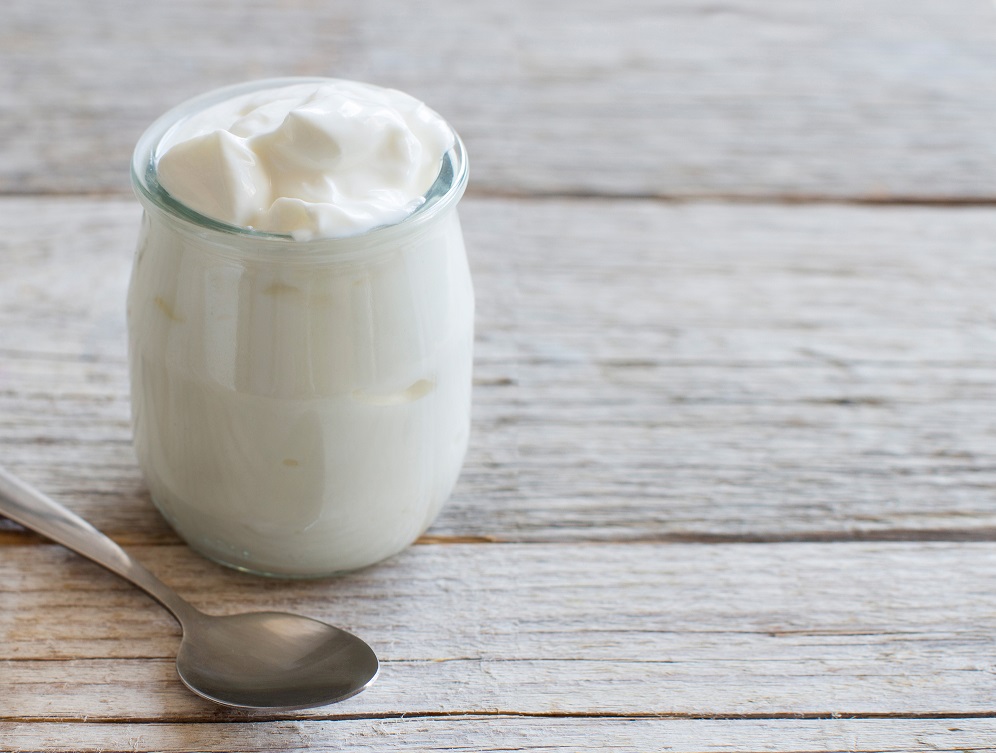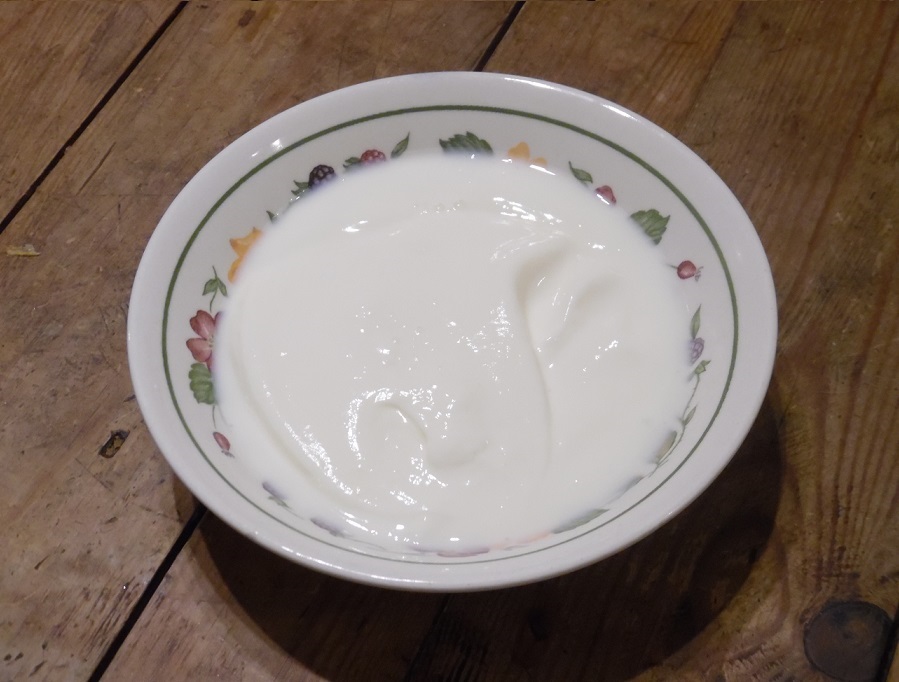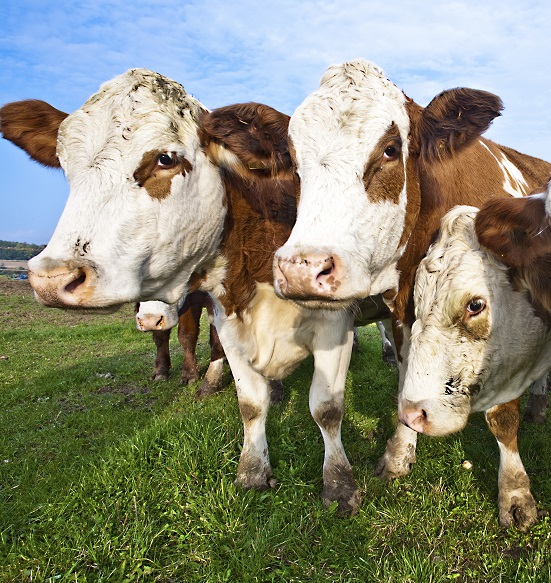 Natural yogurt is a staple of homemade acne remedies. Bio-live yogurt is recommended everywhere, in recipes combined with cinnamon, honey, cucumber, ginger and endless natural ingredients.
Natural yogurt is a staple of homemade acne remedies. Bio-live yogurt is recommended everywhere, in recipes combined with cinnamon, honey, cucumber, ginger and endless natural ingredients.
The reality? Yes, yogurt is an excellent ingredient, to carry other ingredients and increase their penetration due to its fats.
But the potential of topical yogurt goes far beyond what many realise. In short, yogurt is among the weirdest yet most effective moisturisers you can apply to your face.
It has nothing to do with yogurt’s fats, nutrients, or thickness and creaminess. The moisturising properties are entirely down to the bacteria.
Yogurt increases skin hydration and moisture
 Recently, the discovery of healthy gut bacteria has opened a whole new realm of opportunity for acne. Bacteria which lower inflammation, churn out serotonin, and enhance nutrient absorption have all been discovered. There’s millions of these strains and more juicy facts are revealed constantly.
Recently, the discovery of healthy gut bacteria has opened a whole new realm of opportunity for acne. Bacteria which lower inflammation, churn out serotonin, and enhance nutrient absorption have all been discovered. There’s millions of these strains and more juicy facts are revealed constantly.
But there’s another area colonised by microorganisms which is much less investigated – the skin. Many interesting facts have emerged: p.acnes bacteria causes acne, while malassezia yeasts causes pityrosporum folliculitis. P.acnes substrain 1a is much worse for acne compared to beneficial strains. The skin also has colonies of bifidobacterium which can prevent yeast overgrowth.
Knowledge is exploding, and topical creams containing probiotics are becoming increasingly popular. For example, one purchasable probiotic spray contains Ammonia-Oxidizing Bacteria, known as “sweat eating bacteria”.
AOB has the interesting property of consuming ammonia, a component of sweat. During consumption, AOB churns out healthy metabolites which improve skin tone and appearance. Ammonia-oxidising bacteria is found naturally in human skin pores, but in low levels. This spray intends to increase its levels and benefits…
…which brings us to yogurt. Natural yogurt is the most famous biolive food sold widely today. It’s also popular as a topical treatment in Indian Ayuvedic medicine and the homemade recipes of the acne underground.
The specific strains of bacteria in yogurt are Streptococcus thermophilus and Lactobacillus bulgaricus. Both are lactic acid producing bacteria; they consume the lactose sugars in milk and churn out lactic acid in its place. These strains give yogurt its signature taste, since using different strains creates different dairy products such as fermented cheese.
Read Annihilate Your Acne – get the ultimate diet and clear your acne permanently!
The greatness of yogurt for your skin lies within streptococcus thermophilus. This strain is a non-mobile fermentative bacteria. It’s a member of the feared streptococcus family, but completely safe, unlike the disease-causing Streptococcus pneumoniae. Streptococcus thermophilus is not indigenous to human skin, but is excellent once it arrives there. In this study, scientists applied a cream containing high amounts of streptococcus thermophilus to human skin.
After 14 days, the bacteria group enjoyed a significant increase in skin hydration. In the placebo group, nothing changed.
The streptococcus thermophilus significantly increased the skin’s water binding ability, as well as skin barrier function. Trans-epidermal water loss, the quantity of moisture leaving the skin’s outermost layer, fell significantly.
Essentially, this bacteria is an excellent moisturiser, excellent against dry skin, and excellent for skin tone, and this is excellent news for natural yogurt. The greater the fermentation, the more biolive a yogurt, and the more streptococcus thermophilus it contains.
The joys of ceramides…
What was responsible? According to the study, the bacteria strongly increased the skin’s ceramide levels.
Ceramides are fat-based structural compounds in skin which form about 43% of the stratum corneum layer. They’re vital for skin barrier function and reductions are linked to both atopic dermatitis and ageing.
Ceramides have a very important role in retaining moisture, in controlling trans-epidermal water loss, and essentially, keeping water bound in the skin. You could say that while hyaluronic acid stores water and moisture in the skin, layers of ceramides seal the moisture in and prevent its escape.
Recommended – the top 6 vitamins and minerals for acne-free skin
An earlier 1999 study tested streptococcus thermophilus once again, and observed massive, dose-dependant increases in skin ceramide levels after just 7 days. Yet another study detected increased ceramide levels, with bonus benefits of soothing atopic dermatitis symptoms such as scaling and irritation.
Interestingly, acne patients were proven in this study to have lower ceramide levels than average. Topical yogurt can increase ceramide levels, if it’s dense in bacteria.
The normal formation of ceramides begins when an enzyme called sphingomyelinase converts sphingomyelin into sphingosines, one of the main ingredients of ceramides. You don’t need to know exactly how ceramides are formed, just that the sphingomyelinase enzyme is vital. Deficiencies in sphingomyelinase lead to low ceramide formation, poorly hydrated skin, and possibly acne.
…and the connection to yogurt
It turns out that streptococcus thermophilus naturally churns out its own sphingomyelinase, a form which acts identically to human sphingomyelinase.
The studies confirmed that streptococcus thermophilus increased sphingomyelinase activity on human skin. Therefore, it can join forces with your own production lines and massively enhance ceramide formation.
You might expect bacteria to be less active in real human skin. How is a mere bacterial strain supposed to penetrate the depths of human skin, and then gain entry to cells where the ceramide ingredients lie? The likes of p.acnes bacteria only dwell within skin pores.
It turns out that the skin stores sphingomyelin within multiple pools. Some sphingomyelin is stored within deep keratinocyte cells, but some exists on the external surface of cells, while small pools also exist in intercellular space.
Streptococcus thermophilus and its enzymes can reach these two stores, and combine them for a strong increase in ceramides. This mechanism is why the bacteria increased hydration, skin barrier function, and ended atopic dermatitis so well.
Consequently, this is why yogurt is a secret moisturising miracle for your skin. Not because of its fats, but its profile of bacteria. It’s about as obscure a moisturiser as you can use, but a rock solid one.
Hyaluronic acid potential
Also interesting is that streptococcus thermophilus churns out hyaluronic acid, just like it produces sphingomyelinases. Commercial hyaluronic acid used in creams is manufactured using Streptococcus zooepidemicus, and its relative has the power too.
That’s why yogurt is such a strong food source of hyaluronic acid. As we discussed here, hyaluronic acid stores moisture within your skin and increases hydration massively. Declines in hyaluronic acid levels are why older people have dryer, thinner and less elastic skin. Therefore it’s also possible that topical yogurt increases your hyaluronic acid levels.
The flaw is that unlike vitamin C or antioxidants, applying hyaluronic acid topically usually achieves nothing. Hyaluronates are created and organised deep within your skin’s structure. However, there is a chance that bacteria could migrate deeper into your dermis and churn out hyaluounic acid there. It’s also possible that your skin breaks down the fresh hyaluronic acid and recycle its ingredients.
I would put the chances of this power at lower than 50%, but if real, it would make yogurt even more of a moisturising monstrosity.
There is one confirmed topical remedy though – soy milk. Properly fermented soy milk, as opposed to cheaper products, contains high amounts of the bacteria Bifidobacterium breve. Scientists in a 2000 study applied bacteria-rich soy milk to mice skin, and after six weeks, the skin’s own production of hyaluronic acid significantly increased.
The top 7 topical treatments for clearing acne naturally
The benefits also materialised, more moisturised skin and thicker skin. Meanwhile, a team of mice which received unfermented soy milk enjoyed no benefits.
The two compounds believed to explain the increase were genistein and daidzein. Both were present in the fermented milk but not the unfermented batch. These isoflavone compounds are produced by bifidobacterium breve, and have been confirmed separately to increase the density of hyaluronates in skin. Thanks to its bacteria, soy milk contains compounds which indirectly increase hyaluronic acid (the best approach).
Soy milk joins yogurt as another hidden secret for moisturising, and this illustrates the potential of topical probiotics overall.
Other yogurty powers
 Yogurt isn’t particularly rich in vitamin A, vitamin E or vitamin C, although full-fat yogurt is more nutritious. However, it contain surprising amounts of antioxidants, believed to be generated by bacterial activity.
Yogurt isn’t particularly rich in vitamin A, vitamin E or vitamin C, although full-fat yogurt is more nutritious. However, it contain surprising amounts of antioxidants, believed to be generated by bacterial activity.
Proper yogurt is also drenched in lactic acid, and topically applied lactic acid improved skin quality massively after 3 months in this study. At 5% concentration, it thickened and firmed up the epidermis; at 12% concentration, lactic acid thickened and firmed up the dermis and epidermis. The skin grew smoother while wrinkles faded away. What’s better is that lactic acid enhances ceramide formation as well, so it multiplies yogurt’s main benefit further.
Lactic acid is an alpha hydroxy acid along with citric acid, a group which is used in cosmetics for dissolving dead skin cells on the outer layer of the face. What’s weird is that alpha hyroxy acids have a side effect of thinning the skin, but the study above happily contradicts this.
Another advantage the natural fats of dairy like lauric acid and palmitic acid, which will automatically enhance the nutrient penetration. You normally have to add carrier oils to topical treatments, but yogurt comes prepacked. The bacteria will also benefit; the great studies on streptococcus thermophilus used a fat-based cream.
How to find the most bio-live yogurt
The success of yogurt’s acne powers depend entirely on its bacterial content, so how do acquire the holy grail of yogurts?
Your first task is to avoid basic grocery store yogurts. Put simply, artificially flavoured, filler-loaded yogurts are fun foods, not health foods. Being bio-live was never the goal; they’re intended to taste great and appeal to kids while maybe delivering some calcium. Some flavour enhancers of commercial yogurt like aspartame and sucralose actually have antibacterial properties.
Commercial yogurts contain the correct species of bacteria, streptococcus thermophilus, but far from the right content. The glorious seal of “Live and Active Cultures” means nothing. Numerous common brands of yogurt bearing this seal have been analysed and found to contain less than the legally required 100 million live cultures per gram. The seal is often only true at the time of manufacture, not sale.
An organic yogurt brand is vital, but interestingly, many are higher in sugar than conventional versions. They obviously believe they can get away with it, so follow this strategy. The only two ingredients should be organic milk, and live cultures. Get an organic brand which specifically boasts of high probiotic counts.
Full fat yogurt is also vital, because the streptococcus thermophilus was applied in an oil base in the studies. You also need fats for lactic acid and antioxidant penetration, so the ultimate strategy (though definitely not necessary) is to buy organic Greek yogurt. Greek yoghurt is strained to remove additional whey, the protein rich liquid, so what remains is richer in fat. Buying raw milk yogurt is unnecessary, because the lactose which feeds the bacteria is no more concentrated.
Why using raw honey could revolutionise your skin
There’s so many different brands coming and going that it’s hard to recommend a specific one. Whole Foods shops sell highly biolive yogurt brands, and because these products market themselves specifically on their high bacterial content, they’re usually reliable, but always check the label for streptococcus thermophilus. Most yogurts contain this strain, but there are exceptions: the popular brand Chobani is an example.
Also, the sour tang of yoghurt is derived from lactic acid, which is pumped out furiously by the bacteria. Tanginess is therefore a great hidden sign of plentiful bacteria.
If you leave a biolive yogurt in the fridge for two weeks while you go on holiday, you might be pleasantly surprised to find that it’s still edible when you return. You might be unpleasantly surprised to feel like your tongue is melting when you eat it; the tanginess will have multiplied exponentially thanks to neverending bacterial fermentation. The sugar content should have also decreased.
You can therefore tell if your yoghurt is acceptable for acne by simply eating it. Finally, for any UK-based clear skin maniacs, the brand of natural yogurt which I eat, Yeo Valley Natural Yogurt in the big, green, 1kg tubs, contains streptococcus thermophilus as one of its three strains.
The verdict – analysis
Full-fat, organic biolive yogurt is an excellent hidden moisturiser, operating through one of the most obscure mechanisms imaginable. But how useful is yogurt within your overall strategy?
It’s definitely far from necessary. You can acquire glowing and smooth skin from both your diet and by avoiding environmental villains like air pollution. Streptococcus thermophilus isn’t even a natural member of human skin flora. But it’s a truly great bonus strategy, one with minimal downsides.
For acne itself, the opportunities are limited to the moisturising side benefits, but strong and healthy skin is very important for preventing microfissures and skin which is weak in the face of irritants. You will also be less reliant on grocery store moisturisers, some of the worst cosmetics for inflammation. Finally, low ceramide levels are tentatively linked to acne.
The best thing about topical yogurt is its uniqueness. You can nourish your epidermis with fatty acids with grapeseed oil, high-linoleic sunflower oil, or tamanu oil, but yogurt has a secret weapon they don’t. The fats of yoghurt will also provide more traditional moisturising properties. You can surrender to the skin-clearing hive mind and use yogurt in recipes (just avoid lemon juice), or you can use yogurt in isolation.
Regardless, if you are obsessed with anti-ageing, skin tone, and skin smoothness, topical yoghurt is a great topical treatment to try.
NEXT: get the complete strategy for clearing acne naturally
Thanks for reading!